NFkappaB in the mechanism of ammonia-induced astrocyte swelling in culture
- PMID: 18662246
- PMCID: PMC2597622
- DOI: 10.1111/j.1471-4159.2008.05549.x
NFkappaB in the mechanism of ammonia-induced astrocyte swelling in culture
Abstract
Astrocyte swelling and brain edema are major neuropathological findings in the acute form of hepatic encephalopathy (fulminant hepatic failure), and substantial evidence supports the view that elevated brain ammonia level is an important etiological factor in this condition. Although the mechanism by which ammonia brings about astrocyte swelling remains to be determined, oxidative/nitrosative stress and mitogen-activated protein kinases (MAPKs) have been considered as important elements in this process. One factor known to be activated by both oxidative stress and MAPKs is nuclear factor kappaB (NFkappaB), a transcription factor that activates many genes, including inducible nitric oxide synthase (iNOS). As the product of iNOS, nitric oxide (NO), is known to cause astrocyte swelling, we examined the potential involvement of NFkappaB in ammonia-induced astrocyte swelling. Western blot analysis of cultured astrocytes showed a significant increase in NFkappaB nuclear translocation (a measure of NFkappaB activation) from 12 h to 2 days after treatment with NH(4)Cl (5 mM). Cultures treated with anti-oxidants, including superoxide dismutase, catalase, and vitamin E as well as the MAPKs inhibitors, SB239063 (an inhibitor of p38-MAPK) and SP600125 (an inhibitor of c-Jun N-terminal kinase), significantly diminished NFkappaB activation by ammonia, supporting a role of oxidative stress and MAPKs in NFkappaB activation. The activation of NFkappaB was associated with increased iNOS protein expression and NO generation, and these changes were blocked by BAY 11-7082, an inhibitor of NFkappaB. Additionally, ammonia-induced astrocyte swelling was inhibited by the NFkappaB inhibitors, BAY 11-7082 and SN-50, thereby implicating NFkappaB in the mechanism of astrocyte swelling. Our studies indicate that cultured astrocytes exposed to ammonia display NFkappaB activation, which is likely to be a consequence of oxidative stress and activation of MAPKs. NFkappaB activation appears to contribute to the mechanism of ammonia-induced astrocyte swelling, apparently through its up-regulation of iNOS protein expression and the subsequent generation of NO.
Figures


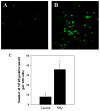
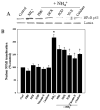
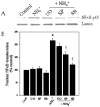
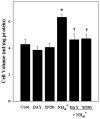
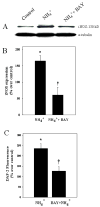

Similar articles
-
Ammonia-induced activation of p53 in cultured astrocytes: role in cell swelling and glutamate uptake.Neurochem Int. 2009 Jul-Aug;55(1-3):98-105. doi: 10.1016/j.neuint.2008.12.022. Epub 2009 Feb 11. Neurochem Int. 2009. PMID: 19428812
-
Trauma-induced cell swelling in cultured astrocytes.J Neuropathol Exp Neurol. 2008 May;67(5):417-27. doi: 10.1097/NEN.0b013e31816fc9d4. J Neuropathol Exp Neurol. 2008. PMID: 18431255
-
Oxidative stress and mitogen-activated protein kinase phosphorylation mediate ammonia-induced cell swelling and glutamate uptake inhibition in cultured astrocytes.J Neurosci. 2006 May 3;26(18):4774-84. doi: 10.1523/JNEUROSCI.0120-06.2006. J Neurosci. 2006. PMID: 16672650 Free PMC article.
-
Interaction of oxidative stress, astrocyte swelling and cerebral ammonia toxicity.Curr Opin Clin Nutr Metab Care. 2010 Jan;13(1):87-92. doi: 10.1097/MCO.0b013e328333b829. Curr Opin Clin Nutr Metab Care. 2010. PMID: 19904201 Review.
-
Astrocyte swelling in hepatic encephalopathy: molecular perspective of cytotoxic edema.Metab Brain Dis. 2020 Apr;35(4):559-578. doi: 10.1007/s11011-020-00549-8. Epub 2020 Mar 7. Metab Brain Dis. 2020. PMID: 32146658 Review.
Cited by
-
Attenuation of sleep deprivation dependent deterioration in male fertility parameters by vitamin C.Reprod Biol Endocrinol. 2020 Jan 11;18(1):2. doi: 10.1186/s12958-020-0563-y. Reprod Biol Endocrinol. 2020. PMID: 31926565 Free PMC article.
-
Dysregulation of Astrocytic Glutamine Transport in Acute Hyperammonemic Brain Edema.Front Neurosci. 2022 Jun 6;16:874750. doi: 10.3389/fnins.2022.874750. eCollection 2022. Front Neurosci. 2022. PMID: 35733937 Free PMC article. Review.
-
Role of mitogen-activated protein kinases in peptidoglycan-induced expression of inducible nitric oxide synthase and nitric oxide in mouse peritoneal macrophages: extracellular signal-related kinase, a negative regulator.Clin Vaccine Immunol. 2011 Jun;18(6):994-1001. doi: 10.1128/CVI.00541-10. Epub 2011 Mar 30. Clin Vaccine Immunol. 2011. PMID: 21450974 Free PMC article.
-
Cellular Pathogenesis of Hepatic Encephalopathy: An Update.Biomolecules. 2023 Feb 19;13(2):396. doi: 10.3390/biom13020396. Biomolecules. 2023. PMID: 36830765 Free PMC article. Review.
-
Novel insights into non-alcoholic fatty liver disease and dementia: insulin resistance, hyperammonemia, gut dysbiosis, vascular impairment, and inflammation.Cell Biosci. 2022 Jun 28;12(1):99. doi: 10.1186/s13578-022-00836-0. Cell Biosci. 2022. PMID: 35765060 Free PMC article. Review.
References
-
- Albrecht J, Jones EA. Hepatic encephalopathy: molecular mechanisms underlying the clinical syndrome. J Neurol Sci. 1999;170:138–146. - PubMed
-
- Baeuerle PA, Baltimore D. I kappa B: a specific inhibitor of the NF-kappa B transcription factor. Science. 1988;242:540–546. - PubMed
-
- Baldwin AS., Jr The NF-kappa B and I kappa B proteins: new discoveries and insights. Annu Rev Immunol. 1996;14:649–683. - PubMed
-
- Bender AS, Norenberg MD. Effect of benzodiazepines and neurosteroids on ammonia-induced swelling in cultured astrocytes. J Neurosci Res. 1998;54:673–680. - PubMed
-
- Bismuth H, Samuel D, Castaing D, Williams R, Pereira SP. Liver transplantation in Europe for patients with acute liver failure. Semin Liver Dis. 1996;16:415–425. - PubMed
Publication types
MeSH terms
Substances
Grants and funding
LinkOut - more resources
Full Text Sources
Research Materials
Miscellaneous

